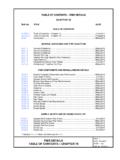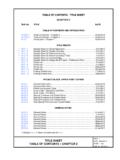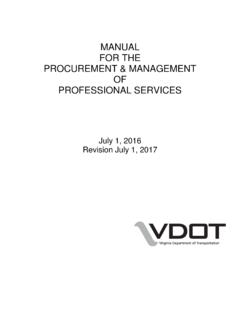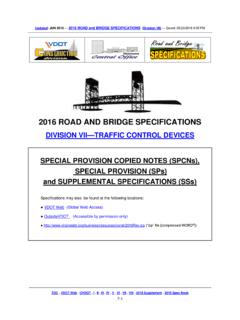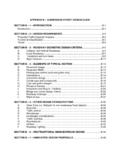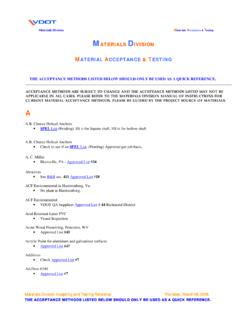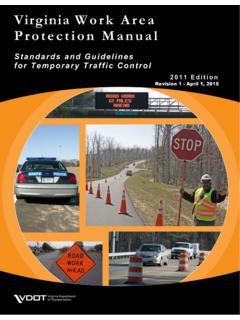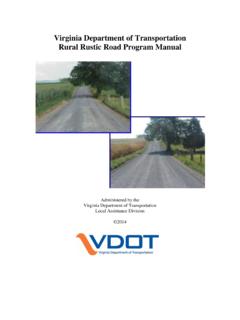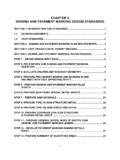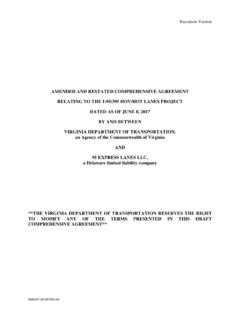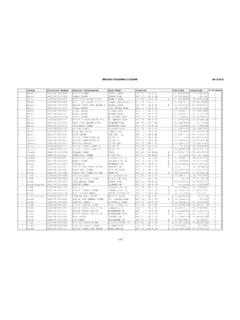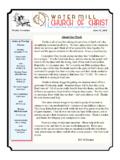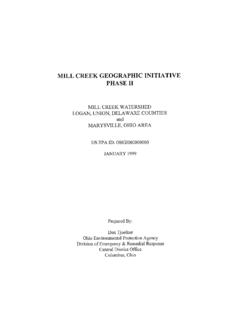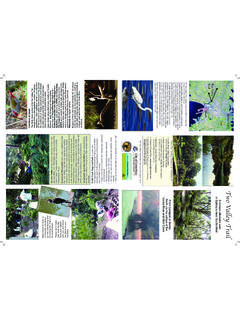Transcription of Special Locality Report 170 - virginiadot.org
1 Virginia Department of TransportationSpecial Locality ReportDaily Traffic Volume EstimatesIncluding Vehicle Classification Estimates33(Franklin County)Information in this Report is included in Reportwhere availableTown of Boones Mill2015 Prepared ByVirginia Department of TransportationTraffic Engineering DivisionIn Cooperation Department of TransportationFederal Highway Administration170 Virginia Department of Transportation Traffic Engineering Division Traffic Monitoring Section The Virginia Department of Transportation (VDOT) conducts a program where traffic count data are gathered from sensors in or along streets and highways and other sources.
2 From these data, estimates of the average number of vehicles that traveled each segment of road are calculated. VDOT periodically publishes booklets listing these estimates. One of these booklets, titled Average Daily Traffic Volumes with Vehicle Classification Data, on Interstate, Arterial and Primary Routes includes a list of each Interstate and Primary highway segment with the estimated Annual Average Daily Traffic (AADT) for that segment. AADT is the total annual traffic estimate divided by the number of days in the year. This booklet also includes information such as estimates of the percentage of the AADT made up by 6 different vehicle types, ranging from cars to double trailer trucks; estimated Annual Average Weekday Traffic (AAWDT), which is the number of vehicles estimated to have traveled the segment of highway during a 24 hour weekday averaged over the year; as well as Peak Hour and Peak Direction factors used by planners to formulate design criteria.
3 In addition to the Primary and Interstate publication, one hundred books are published periodically, one for each of 100 areas across the state defined by VDOT for record-keeping purposes. These books include traffic volume estimates for roads within the county, cities, and towns within the area. These books are titled Daily Traffic Volumes Including Vehicle Classification Estimates, where available; Jurisdiction Report numbers 00 through 99 . Also available are a number of reports summarizing the average Vehicle Miles Traveled (VMT) in selected jurisdictions and other categories of highways.
4 There are many different ways to present traffic volume summary information. Because the user determines the value of each presentation, the reports have been redesigned based on user requests and feedback. The people of the VDOT Traffic Engineering Division Traffic Monitoring Section who produce these books welcome requests for other helpful ways of presenting the summary information. A compact disc (CD) is available that includes files in the Adobe Portable Document Format (PDF) that can be displayed, searched, and printed using common desktop computer equipment. The CD includes the publications described above as well as a number of other reports, including specialized VMT summaries and smaller AADT reports for each city and town separately.
5 Publication Notes Parallel Roads For road inventory and management purposes, some roadways are counted separately by direction and have separately published traffic estimates for each direction of travel. Examples of such roadways are the interstate system and routes with separated facilities and (usually) one-way traffic facilities in urban areas. In these publications, they are referred to as parallel roads. As a convenience for the users of the publication, the listing for segments of roads with parallel segments are published with both the traffic estimates for their own direction of travel ( I-95 Northbound) as well as the estimate of the total of all traffic on the same route including parallel roadways (all directions of I-95).
6 The publication will have a Combined Traffic Estimates for Parallel Roadways on this Route or Combined Traffic identifiers for the combined direction of travel estimates. Roadways such as I-395 with a North segment, a South segment and a separate Reversible lane segment will have the estimate for more than two parallel roadways included in the entire combined traffic estimate. Some routes have very complicated paths through cities and towns. These parallel paths may be too complex to allow a relationship between nearby sections of the opposite direction on the same route. In this case, to indicate that the traffic estimates for such a road segment may not include all directions of traffic on that route, the line that would list the combined values will indicate NA for not available.
7 VDOT s traffic monitoring program includes more than 100,000 segments of roads and highways ranging from several mile sections of Interstate highways to very short sections of city streets. Due to problems experienced obtaining some traffic count data, and the level of quality necessary to maintain confidence in the data, no estimate is currently available for some segments of roadway. These segments are included in the publications indicating NA for not available. It is the intention of the VDOT Traffic Engineering Division Traffic Monitoring group to obtain the data necessary and to Report traffic volume estimates on all road segments included in these publications.
8 Many of the road segments in this program are local secondary roads. The amount and detail of data collected on these roads are not as great as the data collected on higher volume roads. The vehicle classification, average weekday traffic volumes, and the theoretical design hour traffic volumes are not calculated for these roads. The publications indicate NA for the information that is not available. This publication is based on a traffic monitoring program initiated in 1997. Because the data collection techniques and statistical evaluation processes are different than those used in previous years, comparison with previous publications may be misleading.
9 Glossary of Terms: Route: The Route Number assigned to this segment of roadway with the master inventory route number if this is an overlapping route, with official street or highway name if available. Length: Length of the traffic segment in miles. AADT: Annual Average Daily Traffic. The estimate of typical daily traffic on a road segment for all days of the week, Sunday through Saturday, over the period of one year. QA: Quality of AADT: A Average of Complete Continuous Count Data B Average of Selected Continuous Count Data F Factored Short Term Traffic Count Data G Factored Short Term Traffic Count Data with Growth Element H Historical Estimate M Manual Uncounted Estimate N AADT of Similar Neighboring Traffic Link O Provided By External Source R Raw Traffic Count, Unfactored 4 Tire: Percentage of the traffic volume made up of motorcycles, passenger cars, vans and pickup trucks.
10 Bus: Percentage of the traffic volume made up of busses. 2 Axle Truck: Percentage of the traffic volume made up of 2 axle single unit trucks (not including pickups and vans). 3+Axle Truck: Percentage of the traffic volume made up of single unit trucks with three or more axles. 1 Trail Truck: Percentage of the traffic volume made up of units with a single trailer. 2 Trail Truck: Percentage of the traffic volume made up of units with more than one trailer. QC: Quality of Classification Data: A Average of Complete Continuous Count Data B Average of Selected Continuous Count Data C Short Term Classified Traffic Count Data F Factored Short Term Traffic Count Data H Historical Estimate M Mass Collective Average N Classification Estimates of Similar Neighboring Traffic Link K Factor: The estimate of the portion of the traffic volume traveling during the peak hour or design hour.
